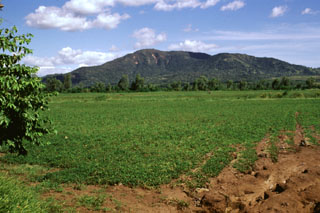Report on Rota (Nicaragua) — February 1991
Scientific Event Alert Network Bulletin, vol. 16, no. 2 (February 1991)
Managing Editor: Lindsay McClelland.
Rota (Nicaragua) No sign of activity despite seismic swarms in the late 1970's
Please cite this report as:
Global Volcanism Program, 1991. Report on Rota (Nicaragua) (McClelland, L., ed.). Scientific Event Alert Network Bulletin, 16:2. Smithsonian Institution. https://doi.org/10.5479/si.GVP.SEAN199102-344060
Rota
Nicaragua
12.55°N, 86.75°W; summit elev. 832 m
All times are local (unless otherwise noted)
"Seismic swarms, which occurred in the late 1970's, had indicated the possibility of an active magma chamber below the volcano. No sign of activity was detected during fieldwork. The most recent (but pre-historic) activity at Rota was a Plinian dacite eruption followed by andesite-dacite lava flows."
Geological Summary. The deeply eroded, forested Rota stratovolcano is located between Cerro Negro and the Telica volcanic complex in the central Marrabios Range. The volcano, also known as Orota, is truncated by a 1-km-wide circular crater whose rim is lowest on the southern side. The latest eruption produced thick andesitic lava flows from a NE-trending fissure NW of the summit. Seismic swarms occurred in 1986, 1989, and 1992, but may have been related to regional fracture systems rather than a magmatic system. Two small NNW-SSE-trending lava domes, El Bosque (also known as Lomas San Ignacio del Bosque or Cerro Ojochal) are located on the plain 2 km N. They were constructed along the same trend as other eruptive fissures that extend transverse to the Marrabios Range volcanoes. An extensive lava field in this area was erupted from numerous small cones and maars.
Information Contacts: B. van Wyk de Vries, O. Castellón, A. Murales, and V. Tenorio, INETER, Apartado 1761, Managua, Nicaragua.

